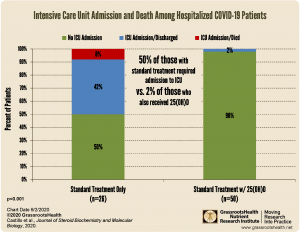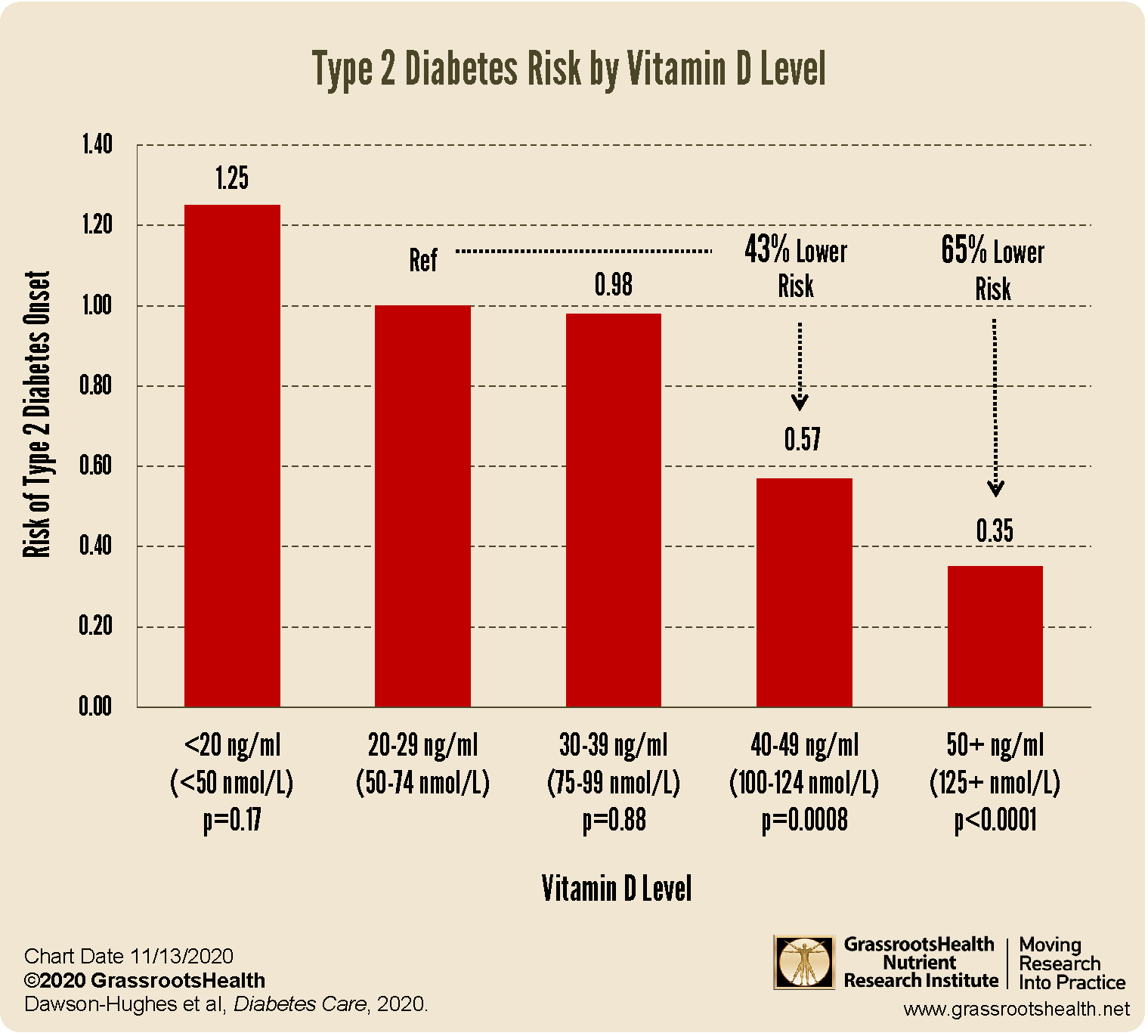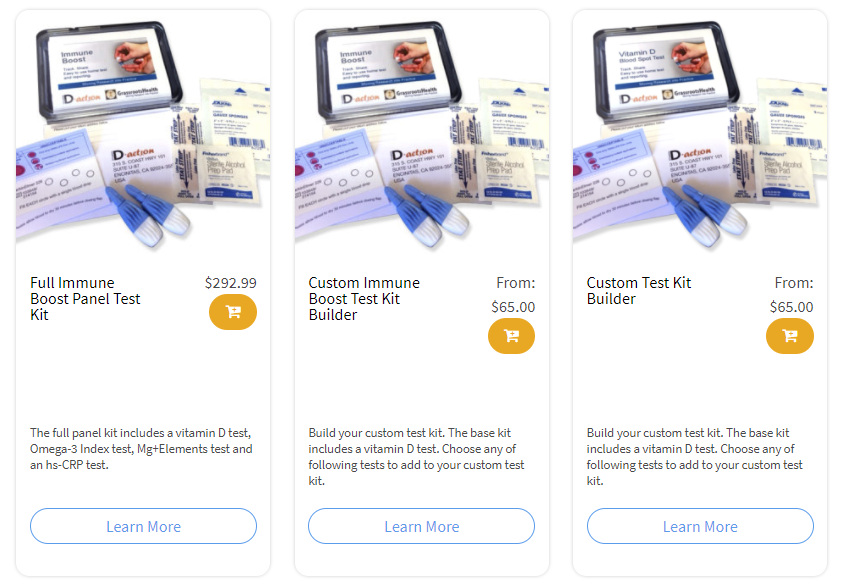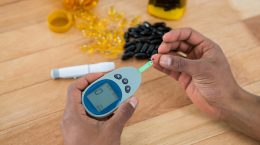Published on November 18, 2020
D2d trial analysis finds strong relationship between those with higher vitamin D levels and a lower risk of type 2 diabetes after insignificant findings by supplement group
 Several studies have shown a decrease in type 2 diabetes incidence and progression among those who either supplement with vitamin D or who have higher vitamin D levels. In recent posts, we have shared about the relationship between vitamin D and insulin resistance (a pre-cursor to type 2 diabetes), as well as the relationship we saw when comparing participants in our GrassrootsHealth cohort to those in the general population – GrassrootsHealth cohort, with an average vitamin D level of 41 ng/ml, had a 60% lower rate of type 2 diabetes compared to the U.S. population, with an average vitamin D level of 22 ng/ml!
Several studies have shown a decrease in type 2 diabetes incidence and progression among those who either supplement with vitamin D or who have higher vitamin D levels. In recent posts, we have shared about the relationship between vitamin D and insulin resistance (a pre-cursor to type 2 diabetes), as well as the relationship we saw when comparing participants in our GrassrootsHealth cohort to those in the general population – GrassrootsHealth cohort, with an average vitamin D level of 41 ng/ml, had a 60% lower rate of type 2 diabetes compared to the U.S. population, with an average vitamin D level of 22 ng/ml!
The D2d Trial – Results “insignificant” by supplementation group?
The Vitamin D and Type 2 Diabetes (D2d) randomized, placebo-controlled trial enrolled 2,423 pre-diabetic individuals to determine the effect of daily supplementation with 4,000 IU vitamin D on the onset of type 2 diabetes. The median follow-up period between enrollment and final assessment was two and a half years, with blood tests at baseline and then every 12 months to check for markers of diabetes (it was from these samples that vitamin D levels were also measured). The original analysis of trial results compared risk between the vitamin D supplement group and the placebo group, finding a 12% reduced risk of type 2 diabetes onset among those taking vitamin D compared to those taking placebo; however that finding was not statistically significant.
What about looking at the serum level instead?
The Heaney Nutrient Study Criteria is a set of guidelines for optimizing the design and analysis of clinical studies for nutrient effects – thus leading to more reliable nutrient trial results. Due to several factors that play a role in how each individual responds to vitamin D supplementation, one of the most important guidelines is to build and test a hypothesis based on nutrient status, not simply intake. An example we use frequently can be observed when looking at the data from a trial by Wagner et al. that found no difference between treatment group, however when analyzing the same data by vitamin D level and ensuring a change over a large enough range, a significant vitamin D effect was observed.
A secondary analysis by Dawson-Hughes et al. was carried out with data from 2,158 participants to determine if there was a relationship between vitamin D levels during the D2d trial and onset of type 2 diabetes. This analysis used vitamin D serum level cut-off points based on a modified version of the National Academy of Medicine’s recommended cut-points: <20 ng/ml (<50 nmol/L), 20-29 ng/ml (50-74 nmol/L), 30-39 ng/ml (75-99 nmol/L), 40-49 ng/ml (100-124 nmol/L) and greater than or equal to 50 ng/ml (125 nmol/L). The referent range was defined as those with a serum level of 20-29 ng/ml (50-74 nmol/L), since that is considered sufficient by the National Academy of Medicine [keep in mind, the GrassrootsHealth scientists panel recommends a level of 40-60 ng/ml (100-150 nmol/L)].
Re-analysis by Serum Level finds Statistically Significant Risk Reduction
For those participants who had been assigned to the vitamin D supplement group, 30% maintained an average vitamin D level of 40-49 ng/ml (100-124 nmol/L), and 40% maintained a level of at least 50 ng/ml (125 nmol/L); only 2% of those in the placebo group reached an average level of 50 ng/ml.
When comparing rates of type 2 diabetes onset by serum level, and comparing each range to the referent range of 20-29 ng/ml (50-74 nmol/L), the analysis found a 43% lower risk for those whose levels were 40-49 ng/ml (100-124 nmol/L), and a 65% lower risk for those whose levels were at least 50 ng/ml (125 nmol/L).
What does this mean?
The finding of this analysis showed that individuals at high risk of developing type 2 diabetes had a lower risk of disease progression by maintaining higher vitamin D levels, with the lowest risk for those maintaining a vitamin D level of at least 50 ng/ml (125 nmol/L).
Do you know YOUR vitamin D level?
Could a vitamin D deficiency be affecting your health? Find out today! Using the GrassrootsHealth Custom Kit Builder, you can create a test kit that measures your vitamin D level and other important nutrients (such as omega-3s and magnesium), as well as your CRP level. Click here to build and order your test kit today – measure your status and take the steps necessary to improve them if needed; make an impact on your health today and for your future! When you know what your levels are, you can determine next steps to take and how much supplementation may be needed if you are not at your target levels.
Concerned specifically about your immune health? Enroll now with the Full Immune Boost Panel (which includes tests for vitamin D, Omega-3 Index, magnesium, zinc, selenium, copper, and hsCRP), and get 10% off when you use coupon code BoostTen at checkout.
What Does it Take YOU to Get Your D to 40 ng/ml (100 nmol/L)?
Did you know your health could be greatly affected by making sure you have a vitamin D level of at least 40 ng/ml (100 nmol/L)? Help us help you.
STEP 1 – Do you know what your vitamin D level is? If not, be sure to test today to find out.
STEP 2 – Determine your target level. Are you at your target level? Experts recommend a level of at least 40-60 ng/ml (100-150 nmol/L).
STEP 3 – Need to boost your level? Use the D*calculator to see how much vitamin D it may take to reach your target. Opt for the Loading Dose for a quicker boost.
STEP 4 – Optimize how your body absorbs and utilizes vitamin D with co-nutrients and these simple steps.
STEP 5 – Re-Test! This is an important step to make sure you have reached your target level, and to ensure you are not taking too much! Re-testing after 3-4 months is recommended.
STEP 6 – Adjust, Repeat…
Give your immune system the nutrients it needs to support a healthy you and protect yourself from unnecessary diseases, especially COVID-19.
NEWS ALERT
 The first Randomized Controlled Trial on vitamin D and COVID-19 has shown a 96% lower risk of ICU admission for those receiving vitamin D (as 25(OH)D to quickly boost vitamin D blood levels) along with the standard treatment, compared to those receiving standard treatment alone.
The first Randomized Controlled Trial on vitamin D and COVID-19 has shown a 96% lower risk of ICU admission for those receiving vitamin D (as 25(OH)D to quickly boost vitamin D blood levels) along with the standard treatment, compared to those receiving standard treatment alone.
These results support many previous observational studies showing a relationship between vitamin D levels and intake and COVID-19 severity.
Review the Latest Nutrient Research for COVID-19
GrassrootsHealth Nutrient Research Institute has launched the new Immune Boost project with the use of our myData-myAnswers nutrient health system that nearly 15,000 people are already using for their health. Specific markers that influence immune health are suggested for testing as part of this project including:
- Vitamin D
- Omega-3 Index
- Essential elements magnesium, selenium, and zinc
- hsCRP
Our goal is to demonstrate how one can use the Nutrient Research Model established by Dr. Robert Heaney to show the effect of vitamin D serum levels of at least 40 ng/ml (100 nmol/L) on risk reduction for all ethnicities in the population. Status and intake of other nutrients will also be analyzed for any type of relationship to immune status and symptom severity. Join the project today!
Please let us know if you’re interested in helping sponsor this project.
CLICK HERE for updates and new information about the project.
Through GrassrootsHealth Nutrient Research Institute, you can also test your essential elements magnesium, copper, zinc and selenium, toxins such as lead, mercury and cadmium, as well as your omega-3 levels, inflammation levels and thyroid stimulating hormone (TSH) level. Find out your levels today! Log on to the test selection page (click the link below) to get your tests and see for yourself if your levels can be improved.
Make sure you track your results before and after, about every 6 months!
Click Here to Access the Test Page
How can I track my nutrient intake and levels over time?
To help you track your supplement use and nutrient levels, GrassrootsHealth has created the Personal Health Nutrient Decision System called
For each specific supplement, you can track what days you take it, how much, and many other details. This will help you know your true supplemental intake and what patterns of use work for you to reach and maintain optimum nutrient levels. Check it out today!










